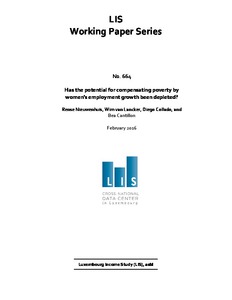Has the potential for compensating poverty by women's employment growth been depleted?
"Although employment growth is propagated as being crucial to reduce poverty across OECD countries, the actual impact of employment growth on poverty rates is still unclear. This study presents novel estimates of the impact of macro-level trends in female labour force participation on trends in...
| Main Authors: | , , , |
|---|---|
| Institution: | ETUI-European Trade Union Institute |
| Format: | TEXT |
| Language: | English |
| Published: |
Luxembourg
2016
LIS |
| Subjects: | |
| Online Access: | https://www.labourline.org/KENTIKA-19106455124919246379-Has-the-potential-for-compensa.htm |
| Summary: | "Although employment growth is propagated as being crucial to reduce poverty across OECD countries, the actual impact of employment growth on poverty rates is still unclear. This study presents novel estimates of the impact of macro-level trends in female labour force participation on trends in poverty, across 15 OECD countries from 1971 to 2013. It does so based on over 2 million household-level observations from the LIS Database, using Blinder-Oaxaca decompositions. This method allows for disentangling the impact of increasing women's employment rates from other possible confounders driving poverty outcomes. The results indicate that an increase of 10 percentage points in the female labour force participation rate was associated with a reduction of 1 percentage point of poverty across these countries. The increase in women's employment has had a significant impact on poverty trends. However, in the Nordic countries no such poverty reducing effect was found, as in these countries womens employment rates were very high and stable throughout the observation period. In countries that initially showed marked increases in women's employment, such as the Netherlands, Germany, Spain, Canada, and the United States, the initial increases in women's employment rates were typically followed by a period in which these trends levelled. Hence, our findings suggest that the potential of following an employment strategy to reduce poverty in OECD countries has, to a large extent, been depleted." |
|---|---|
| Physical Description: | 34 p. Digital |

